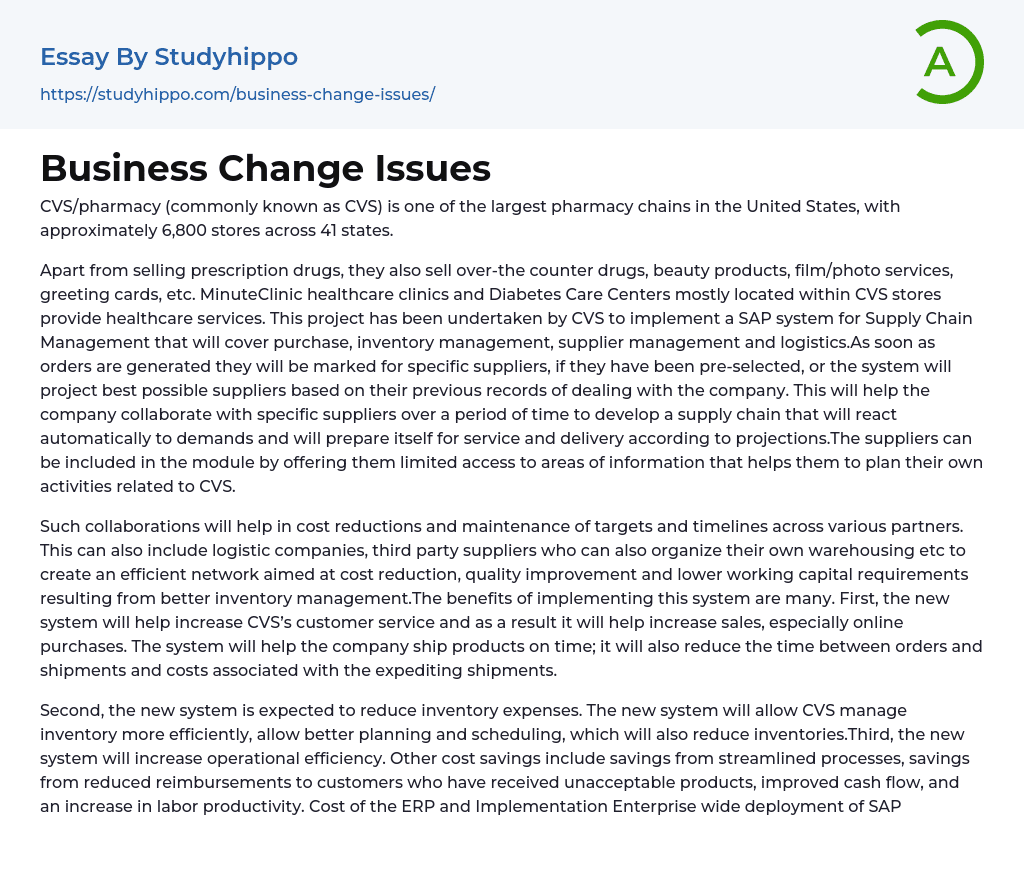With approximately 6,800 outlets operating across 41 states, CVS/pharmacy is a notable pharmacy franchise based in the US.
CVS offers a variety of products and services, including prescription and over-the-counter drugs, beauty products, film/photo services, and greeting cards. MinuteClinic healthcare clinics and Diabetes Care Centers are also located within CVS stores, providing healthcare services. The implementation of a SAP system for Supply Chain Management is underway, covering purchase, inventory management, supplier management, and logistics. Orders are assigned to specific suppliers, either pre-selected or selected by the system based on past records. This collaboration with suppliers allows for the development of a supply chain that can react to demands and prepare for service and delivery based on projections. Suppliers can also be included in the module with limited access to information to plan their own activities related to CVS.
Implementing collaboration
...s with various partners, such as logistic companies and third-party suppliers, can result in cost reductions, better inventory management, and improved quality. These partnerships can enable efficient networks, which may include outsourcing of warehousing, aimed at meeting targets and timelines. The benefits of this system are multifold. By selecting this approach, CVS can enhance its customer service, leading to an increase in sales, particularly for online purchases. Additionally, the system can help ensure timely product delivery, diminish the time-gap between orders and shipments and lower costs incurred from expediting shipments.
According to CVS, the implementation of the new SAP system will bring cost savings in various ways. One benefit is a reduction in inventory expenses due to better management, planning, and scheduling. In addition, the system will increase operational efficiency through streamlined processes, reduced reimbursements for unacceptable products,
improved cash flow, and higher labor productivity. However, this implementation is expected to cost CVS over $500 million over five years. As of 2008, CVS's annual revenue was around $80 billion with an income exceeding $2 and ranked 24th on the Fortune 500 list.
The company has around 6,800 pharmacy stores with a total of 6 billion in revenue. All stores will eventually need to be connected to the central system. The company currently employs 190,000 people. The implementation of the ERP will involve training an average of 3 users at each store and over 100 users at the head office. The ERP license costs are estimated to be around $200 million, while implementation and training will cost approximately $300 million. However, cost overruns may occur if the timeline is extended or if more training is required for additional branches.
The company must prioritize planned change management to avoid implementation failures during the roll-out plan, which will follow a schedule to be worked out with SAP. A broad description of the work is being discussed.
The management must handle ground difficulties carefully in implementing change, as resistance is often due to misconception. A change plan should involve top leadership to inspire and ensure smooth transition. Implementation failure can result from lacking change policies. Adoption of new work processes requires meticulous management, as it causes a significant change in the organization and affects every individual and department when a system is installed and implemented.
Three categories of strategies are required for successful management of significant change: Organizational Strategies, Technical Strategies, and People Strategies. Organizational strategies involve developing and deploying a change strategy, utilizing change management techniques, overseeing project
management, modifying organizational structures and resources, adjusting managerial style and thinking, promoting coordination, and emphasizing Information Technologies (Al-Mashari and Zairi 2000). Technical strategies encompass installing enterprise solutions, understanding and explaining complexities, arranging in-house technical capability, as well as managing time and cost (Sarker and Sarker, 2000). People strategies entail training staff, including managing attitudes and behaviors of management (Gable and Stewart 1999).
The responsibility of formulating change policies falls on the management, as implementation teams are not equipped to devise strategies for adoption. Users exhibit resistance towards software due to their perception of it being a risk and a potential threat to their position in the organization. Additionally, they have become accustomed to their current mode of operation which they deem superior to the new system. The failure of implementing change can often be attributed to rumors or misinformation, usually originating from outsiders and breakdowns in communication within management.
Larry Smeltzer (1991) stresses the significance of face-to-face conversations in creating convincing and vital communication between the Change Managers and employees. According to him, using a memo to convey instruction or information is too cold and impersonal, resulting in lean communication.
- Adaptation essays
- Adventure essays
- Adversity essays
- Aging essays
- Alcohol essays
- Barbie Doll essays
- Beauty essays
- Care essays
- Carpe diem essays
- Change essays
- Chess essays
- Chicken essays
- Choices essays
- Contrast essays
- Crops essays
- Development essays
- Dream essays
- Evil essays
- Experience essays
- Family essays
- Farm essays
- Fire essays
- First Love essays
- Focus essays
- Greed essays
- Hero essays
- Holiday essays
- House essays
- Housing essays
- Humility essays
- Humor essays
- Hypocrisy essays
- Integrity essays
- Law of Life essays
- Life Changing Experience essays
- Life Experience essays
- Lifestyle essays
- Limitations essays
- Love Story essays
- Mother Tongue essays
- Motherhood essays
- My Neighborhood essays
- Myself essays
- Mystery essays
- Narcissism essays
- Never Give Up essays
- Nursing essays
- Object essays
- Opportunity essays
- Peel essays




